Why SAP Leonardo Seems So Fake
Executive Summary
- Leonardo is an IoT/Big Data “solution” marketed far too early by SAP.
- We evaluate Leonardo’s exaggerated claims and how SAP has attempted to blend SAP with IoT in the minds of customers.

Video Introduction: The Real Story of Leonardo
Text Introduction (Skip if You Watched the Video)
SAP has created tremendous hype around Leonardo. An unbiased analysis is necessary of what it is and the probability that SAP’s statements on Leonardo are true. SAP states that Leonardo is enabled by HANA, and machine learning, and SAP Cloud Platform. Furthermore that Leonardo is a development platform and that connects product life cycle operations for track and trace. We lay out the criteria that one should use to evaluate an IoT solution and measure how SAP and Leonardo stack up. You will learn both SAP’s projections on Leonardo and our analysis of this by an entity with no association or financial bias.
Our References for This Article
If you want to see our references for this article and other related Brightwork articles, see this link.
Notice of Lack of Financial Bias: We have no financial ties to SAP or any other entity mentioned in this article.
What is SAP Leonardo?
SAP announced something called Leonardo at SAPPHIRE 2017. SAP Leonardo, according to SAP, looks something like this.
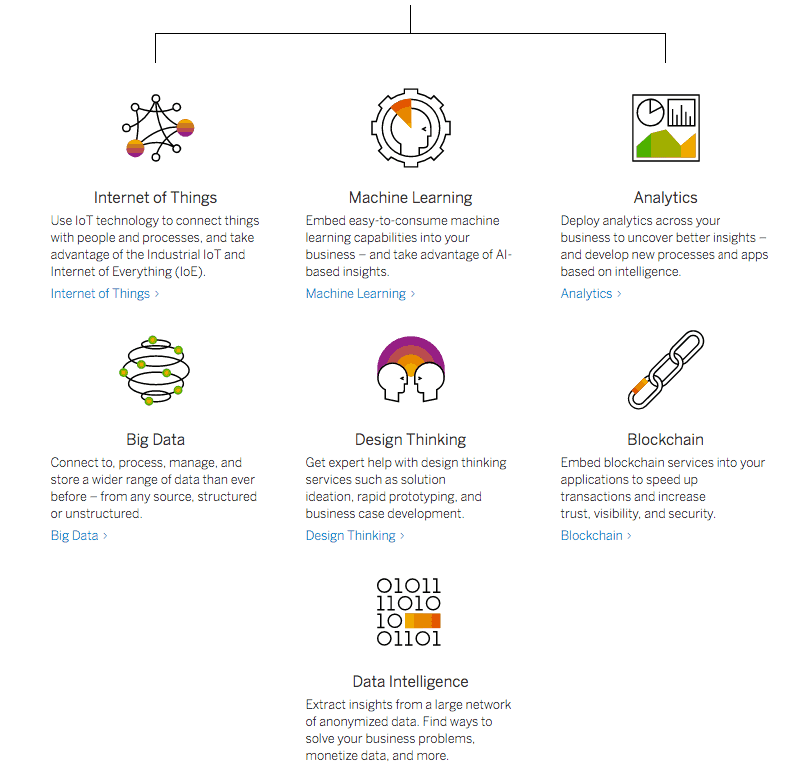
These are a collection of things that SAP has been talking about for some time. Design Thinking is not something in SAP’s software per se but is an approach that SAP has rolled out to everything from product development to sales.
The Logical Problems with SAP Leonardo
SAP demonstrates a problem when it describes SAP Leonardo that has plagued it for some time. And that problem is an overreliance upon buzzwords and concepts that have yet to meet with much commercial success. In an article by Sanjeev Singh, I found the following terms used.
- …kick off your digital innovation journey
- …an innovative portfolio of IoT (Internet of things) solutions to help you extend your digital core (SAP S/4 HANA) with adaptive (machine learning) applications, big data applications, and connectivity to imagine and implement new business processes, new business models, and most importantly, new possibilities in human life.
When you start using language in this way, it becomes evident that there are many salesmanships and marketing puffery involved.
- Why would SAP use the term “digital innovation journey?” Is the implementing company innovating, or are they engaging in systems implementation?
- Does SAP have an innovative portfolio of IoT? Does SAP presently actually receive revenue of any substance from IoT?
- Why is the term digital core being used to replace the term ERP? What was wrong with the term ERP?
- Does SAP receive revenue of any substance from machine learning? Is SAP known as a machine learning company?
- Why is the term “new possibilities in human life” used? What is that adding to one’s understanding of SAP Leonardo?
The PLAT.ONE Acquisition
SAP acquired the very small PLAT.ONE software vendor. PLAT.ONE is doing what SAP would like to do (although on a tiny scale), so SAP purchased them. However, PLAT.ONE had nothing to do with SAP before its acquisition. In fact, for some reason, Plat. One did not connect to HANA.
“PLAT.ONE is built using Hadoop and HBase to store unstructured and high-volume data streams. It provides a rich database abstraction layer that integrates with MySQL, MS SQL Server, Oracle and other SQL and No-SQL storage.”
I assume that this web page will be updated to point out that PLAT.ONE will connect to HANA, and the other databases will be de-emphasized. Most likely, SAP marketing is already at work changing the web page to say that PLAT.ONE works with SAP—however, PLAT.ONE did not need or connect to an SAP HANA database. And one should also notice that there is nothing here talking about PLAT.ONE connecting to any ERP system, for instance, S/4HANA. That is because IoT does not have anything to do with ERP systems. But SAP will need to superimposed S/4HANA into the mix so that the IoT data is in S/4HANA so SAP can make the connection argument.
As a researcher who is primarily dedicated to studying SAP, I find it unlikely that SAP will do much with PLAT.ONE. SAP did not integrate BusinessObjects into BW as promised. It did not leverage SuccessFactors except for learning about Cloud/SaaS from them. It is not leveraging Ariba. It did not leverage several acquisitions in the CAD/CAM space and PLM space to do anything with its PLM solution. It did little with the Sybase acquisition. So, therefore, it seems more likely than not that SAP will not do much with PLAT.ONE.
What The Usual Suspects Say About Leonardo
The usual suspects of SAP consultants publishing material, Computer Weekly, Diginomica served as repeating engines for SAP’s press packets present a positive viewpoint on Leonardo. None of these entities questioned anything that SAP wrote and performed their duty to SAP admirably. They once again helped to create the echo chamber that SAP desires. SAPPHIRE 2017 is still pretty recent, so what will come next is a series of pro-Leonardo articles by consulting companies that see Leonardo sell more consulting business. In one that is already published, all of SAP’s projections were accepted as true. Then some case studies were mentioned that intend to illustrate that companies are already using Leonardo to improve their business.
Exaggerated Claims on SAP Leonardo
Something like SAP Leonardo requires exaggerated claims. According to the SAP IoT Overview presentation, Harley Davidson is already using SAP’s IoT.
“Reduced production lead time for customized motorbikes from 21 days to 6 hours.”
No explanation is given how SAP did this. But one is supposed to accept it uncritically.
SAP has a video on The Port of Hamburg, which provides very little information on what was done to the customer.
This video has been removed by SAP from YouTube for whatever reason.
The following video is on digital farming is far better, as in at least some details of what was done are explained.
The problem with this video is that it covers many different areas, IoT being just one.
Secondly, it seems to make the mistake of generalizing all technological advances in farming to SAP. In one scene, the farmer is using a non-SAP system to measure the composition of feed. There is a digital readout on a combine – that is being sent to a central location (I assume). In another, a drone selectively drops insect predators onto parts of a field where it has determined that there are pests.
How much of this is SAP software?
Is SAP explaining what their software does in this video or providing a documentary into new farming information technologies? SAP’s logo shows up at the end of the video, but it is unclear why SAP showed nothing to do with SAP.
This video has been removed by SAP from YouTube for whatever reason.
This is the IoT video of an Italian train operator named Trenitalia. The CIO of Trenitalia first presents the idea that its IoT strategy in improving predictive maintenance by recording train data depends on HANA. However, according to this CIO, the amount of data collected on an annual basis will exceed 700 terabytes. If that is true, this data cannot be kept in HANA.
HANA for Big Data? Or Big $$$$ Data?
HANA is the most expensive database you can purchase, and it is priced by GB (this is covered in the article The Secret to Not Talking About the Cost of HANA). And it also has the highest TCO due to rather apparent factors (immaturity, labor costs, cross-component requirements, etc.). Therefore, for Trenitalia, the maintenance data may be housed in HANA for only the shortest of times, then quickly migrated to a database with unlimited storage or storage whose price is not related to the data’s size. This will be challenging as, according to Trenitalia, roughly two terabytes of data per day will be collected. Because of this volume, I see the difficulty in how HANA fits into Trenitalia’s plans.
Later in this same video, the Head of Technical Division states that HANA processes the system. That is not technically accurate. It is stored in HANA. HANA is a database, so it is not processed, as in, analyzed by HANA.
Leonardo as Enabled by HANA?
Leonardo was further promoted by SAP as a mechanism for leveraging HANA in the PR release by SAP SAP’s HANA Bet Seems to be Paying Off.
The ability to handle IoT data is quickly becoming a “must have” in the database world, and we’re just beginning to see how sensor data can be leveraged to create new efficiencies. Mercedes Benz, for example, combines sensor data from automobiles in production with ERP systems hosted on HANA and then applies machine learning analytics to improve development and reduce production costs.
This isn’t easy to do from scratch — and that’s where SAP’s new release provides big wins. It offers 70 predictive algorithms out-of-the-box including those that run on live streaming, series and spatial data. These algorithms learn and self-improve to facilitate machine learning.
SAP has been trying hard to co-opt IoT and Machine Learning…
Ahhh….the White Unicorn of Machine Learning!
If we look at machine learning, which is the new rage among buzzwords, how much machine learning is currently implemented in companies. I ask because I don’t see any.
Indeed, more massive data sets and more powerful processors, and specialized logic provide more machine learning opportunities. But machine learning is connected to AI, and AI goes back decades. And how many applications have we seen of AI? The most AI thing I have been exposed to is my Google Home unit. However, it seems like AI, but it has a somewhat limited number of pathways that it follows. But Google is far better positioned than SAP to bring out machine learning.
Then the description continues:
“SAP HANA Cloud Platform is the key strategic platform as a service infrastructure and provides framework for SAP Leonardo Innovation System. The figure below shows the key components of Leonardo – SAP Leonardo Foundation, SAP Leonardo Bridge and SAP Leonardo for Edge computing and how they tie together in SAP Cloud Platform or SAP HANA Cloud Platform framework.”
If that is true, then SAP Leonardo is not off to a good start. The SAP HANA Cloud Platform, which is now just called the SAP Cloud Platform, never had anything to do with HANA, as is explained in the article, Was The HANA Cloud Platform Designed for HANA Washing?
SAP loves to distribute Leonardo through their presentations because it allows SAP to promote virtually all of SAP’s solutions, as Leonardo is presented as a universal glue.
Leonardo is a toolkit used by very few SAP customers, and most of what SAP says about Leonardo is what SAP would like Leonardo to be, not what it is. SAP states that the SAP Cloud Platform will help companies leverage Leonardo, but there is no truth. SAP’s website says that Leonardo is a significant benefit of moving to the cloud.
The Reality of SAP’s Cloud Platform
The SAP Cloud Platform has not received uptake very much, and it is a PaaS or platform as a service. There is a question as to whether it makes sense to use SAP as a PaaS as you can receive a more competent offering from AWS, Azure, or even Google. But if SAP Leonardo ends up being the value-add that SAP says it will be, then there is no reason that it can’t be hosted at one of these PaaS vendors.
“SAP Leonardo Foundation provides Leonardo business services that enable you to build IoT applications through reusable application services and applying predictive algorithms, and Leonardo technical services to process high velocity data with ability to stream analytics and run predictive scenarios. The Leonardo business services are nothing but reusable microservices framework that allow you to rapidly build your IoT model and connect it with business contexts from back-end systems and by also leveraging configuration tools. Leonardo technical services leverages SAP Cloud Platform that provides end-to-end microservices for machine learning, analytics, big data connector, security, user management, and back-end integration APIs.”
So this paragraph has SAP marketing’s hands all over it. It is entirely unrealistic and filled with buzzwords. This paragraph continued, but it merely progresses along the same line of describing SAP Leonardo as some infinitely complex Rube Goldberg device.
Leonardo Foundation as Development Environment
If I can paraphrase, SAP Leonardo Foundation is a development environment with components where you can build IoT applications using analytics. Now we will get to the quotations about what SAP Leonardo “connects.” At SAPPHIRE 2017, Hasso Plattner called SAP Leonardo “a set of tools to build new-style applications.” Therefore, SAP Leonardo is naming for a template on things that already existed before SAP Leonardo was named. SAP has HANA; they have Lumira; they now have PLAT.ONE. If you buy these different components from SAP, you can build an IoT system. And SAP has some ideas about how you should configure these components to capture and analyze IoT data.
What SAP Leonardo “Connects”
“Connected Products enable end-to-end visibility of product life-cycle operations and provide ability to connect, monitor and control large number of customer facing products, manage, control, and respond to changing conditions with a digital operations center for response.
Connected Assets allow us to track, monitor, analyze and maintain all fixed assets across the network. With connected production systems, assets, manufacturing and maintenance business processes, we can reduce operational and maintenance costs and increase the up time of assets.
Connected Fleet enables businesses and public sector organizations (owning fleet) to collect live telemetry and sensor data and integrate it with core business processes to improve services and safety for operators, improve visibility to logistics, and finally, provide a better service to their customers.
Connected Infrastructure delivers new forms of digital operational intelligence to transform physical-infrastructure systems. Leveraging real-time building insights, we can optimize energy consumption, maintain facilities and equipment and ensure improved customer satisfaction. We can manage end-to-end construction projects and optimize energy utilization by integrating processes and information.
Connected Markets enable innovation, production, deployment and business formation of local relevance at the right moment in time to meet challenges of tomorrow and transform it into opportunities for today. In this market we can interact in an all knowing digital or physical market place to provide an excellent all around personal experience.
Connected People will improve lives, work and health by connecting people and communities and providing better lifestyle experiences and opportunities for organizations to evolve into new business models. It can help workers stay safe, build a connected health network, and make home life more comfortable, and secure.”
So basically, SAP Leonardo, according to SAP, will allow one to connect various items and then analyze them. But actually, that can’t be accurate.
Findings or Repeating What SAP told You?
SAP Leonardo does not provide connections because those connections are enabled through the actual data collective devices. So SAP Leonardo allows the analysis of connected devices, and I consider that an important distinction.
At the bottom of the article, this is stated by the author.
“Information and views expressed in this article are based on my findings and I do not claim its accuracy and validity in any way.”
This can’t be right. Something is very wrong as an author when you write something like this. It is an abdication of your responsibility to fact check for the reader.
First, this article is not the author’s “findings.” This article is a restating of what SAP stated. You cannot use the term “findings” to describing copying something. The author of this article has quotations from SAP but has not listed them as quotations in his article. This is a problem for many SAP consulting companies using SAP’s quotations but without providing the source. These are the statements of SAP, and one may not claim their accuracy or validity. If one calls something findings, that means that you analyzed the information.
But at least the author admits what they do not know. Most people who write on SAP restate SAP’s statements and then never cover the fact that they don’t know if they are true. SAP states it, and in their mind, at least, it must be true.
Criteria for Predicting the Success of an SAP Initiative
There are a couple of criteria I look for to determine if a new SAP initiative will be successful.
- Criteria 1: Previous Experience: Is what is being introduced something SAP has been successful with before or is it related to something SAP has been successful with before?
- Criteria 2: SAP’s Area Capabilities: Does SAP have capabilities over other vendors in the area aside from merely their size?
- Criteria 3: Ability to Use the Integration Argument: Can SAP use its control over the other applications a company uses to extend into this area?
- Criteria 4: A Logical Software Category for SAP?: Does the area that SAP is describing inherently make any sense? That is, does it hold together?
From that set of criteria, I then give each item a 1 to 10 rating with low or no and ten being high or yes. Let us see how SAP Leonardo scores on this system.
Criteria 1: Previous Experience
SAP has never been successful in anything similar to SAP Leonardo previously.
Previous Experience Score: 1
Criteria 2: SAP’s Area Capabilities
SAP has some of what SAP Leonardo describes with its analytics offerings. However, BW and Business Objects are again applications that aren’t worth porting to this solution. The best analytics SAP has Lumira, but it apparently has all implementation limitations and is not seeing much uptake. That would be by choice to be part of SAP Leonardo, but SAP needs to build out its backend. However, outside of analytics, SAP does not have anything else that matches what I see described here, aside from their acquisition of PLAT.ONE, which is an acquisition and was very small at the time it was acquired. SAP has never had anything predictive outside of forecasting. In forecasting, they have SAP DP, which would not be useful in this overall design. The same applies to IBP, which I covered in SAP’s IBP Open Questions and Opportunities.
So SAP is starting from scratch there. SAP has no prominence in machine learning, and while I searched, I could not find any machine learning acquisition they had performed. In my reading, SAP has done little but issue statements that they are interested in machine learning and see it as the future.
SAP’s Area Capabilities, Score: 4
Score Reasoning (The things that SAP does have for Leonardo many other vendors have. The things that SAP needs, which are are more complicated to develop, SAP has no background in)
Criteria 3: Ability to Use the Integration Argument
SAP always has the advantage in SAP customers as it can often convince customers to use their offering as it connects to ECC or SAP’s ERP system. That allowed SAP to get into many areas where they had no background and poor quality offerings. But the issue is that are things like people and assets connected to the ERP system. In HR, they have the records of people, but they are not connected to physical people. And SAP is moving away from HR in ERP to a stand along with the solution. In vehicles, they aren’t. In other assets like factory equipment, they could be, but they aren’t. MES systems connect to the factory’s actual equipment, and MES systems are often connected to ERP. So it is a bit of a mixed bag. But this is SAP’s most potent play. They would need to get companies to see ERP as a way to connect all of their devices.
This is not actually what ERP was designed for, and it would not have an advantage over creating a separate hub for this type of IoT information. But SAP still might be able to convince companies to do this, and for those companies, SAP would have a substantial advantage in then selling them something like SAP Leonardo. This is, in fact, likely why SAP Leonardo has been so pre-announced. There may be little to SAP Leonardo, but SAP signals to their customers that they should be connecting devices to SAP ERP.
Ability to Use the Integration Argument Score: 4
Criteria 4: A Logical Software Category for SAP?
It is difficult to say.
Something that goes unmentioned is that companies drastically underuse the information they already collect. IoT creates haystacks of information that must be organized and analyzed. In the short to medium term, I would not see IoT as a big opportunity if we take the example of factory equipment. Do companies benefit from knowing exactly what that equipment is doing at any time? So the milling machine is milling at a specific rate per hour, and that compares versus the specification as it runs 20% below capacity. I suppose there could be a benefit to knowing that, but there is also the question of analytical bandwidth. Developing what SAP is describing is a lot of work and will require many new areas to be developed. Some things, like truck locations, are already known by companies through GPS tracking.
It is much more difficult to project longer-term as who could have imagined that you could have a computer in your pocket that you would use as a phone? Furthermore, that everyone would have one? But it is difficult to see the vision of SAP Leonardo happening for some years:
A Logical Software Category for SAP Score: 2
Score reasoning (Based on the short to medium time horizon).
The average of these four scores is 1 + 4 + 4 + 2 = 11/4 = 2.75. I could correlate this to a probability, so a 27.5%, roughly of course, of SAP being successful with Leonardo.
SAP’s Neophyte IoT Status
If I offer to come over and bake you a cake for money, you should not accept my offer. Why? Well, for one, I have never baked a cake in my life. Now I may have some of the ingredients in my home. But those ingredients can be found anywhere. I have not brought anything special to the table that you can’t get anywhere else.
SAP will continue to talk up IoT; their complaint partner network will reinforce them. However, SAP is starting with really nothing for SAP Leonardo. I am confident that if a customer were to purchase SAP Leonardo right now, it would be a development project.
SAP cannot answer why an ERP system like SAP ECC or S/4HANA, which has been designed to decrement inventory, post goods issue, etc., is an efficient platform for aggregating IoT data?
What is SAP’s “Real Control Over” IoT Master Plan
SAP is not currently a player in IoT. In fact, IoT is a bit of a future-oriented technology or set of technologies at this point. SAP has big plans for IoT, and they talk about it regularly, even when the topic being discussed has nothing to do with IoT, as the following quotation from their Q1 2017 analyst call demonstrates.
“Yes, I think people forget that the S/4HANA ERP, there is nothing out like it in the market at all. When you look what it does and how it changes businesses and how it connects digital supply chains, it is by far the next generation ERP and everyone else is far way behind. And then when you connect everything, the machine learning and IoT and analytics space…”
SAP continually does this, even though SAP does not have IoT business. So they don’t have a real IoT offering and don’t make money from IoT, but they continually talk about IoT.
Get Customers to Commingle SAP with IoT in their Minds
Therefore, SAP needs to get companies to place its data into SAP’s ERP system so that then SAP can apply the integration argument to divert customers away from better providers in IoT and machine learning. This is not actually what ERP was designed for, and it would not have an advantage over creating a separate hub for this type of IoT information. But SAP still might be able to convince companies to do this, and for those companies, SAP would have a substantial advantage in then selling them something like Leonardo. This is, in fact, likely why Leonardo has been so pre-announced.
And this gets into what is SAP’s current control over IoT data.
SAP’s Control Over IoT Data?
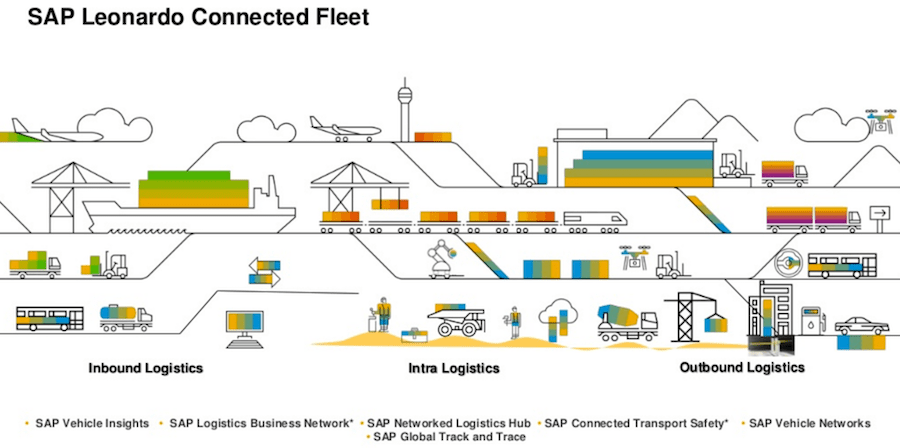
This is a logistics graphic. It covers all the modes, ports, rail yards; it even includes drones (in the upper right-hand corner). The title of this slide is SAP Leonardo Connected Fleet. However, what is the major problem with this slide with regards to SAP? Well, for one, SAP has almost none of the transportation market in software. SAP makes a product called SAP TM, but it is very lightly installed. I have analyzed TM versus competitors offering in this article SAP TM Verus MercuryGate.
SAP makes another product for warehousing called EWM, which is again very lightly installed. SAP ERP has a mini-module called WM, a highly simplified WMS, but it is a glorified inventory management module. Therefore SAP’s installed base when it comes to logistics is shallow.
Therefore, SAP is proposing something in this graphic that does not exist. SAP provides and maintains none of the data for what is in this graphic.
To SAP to pull off its integration argument, that is, customers should accept lower capability SAP applications in any area; SAP needs to control the data already to be accessed.
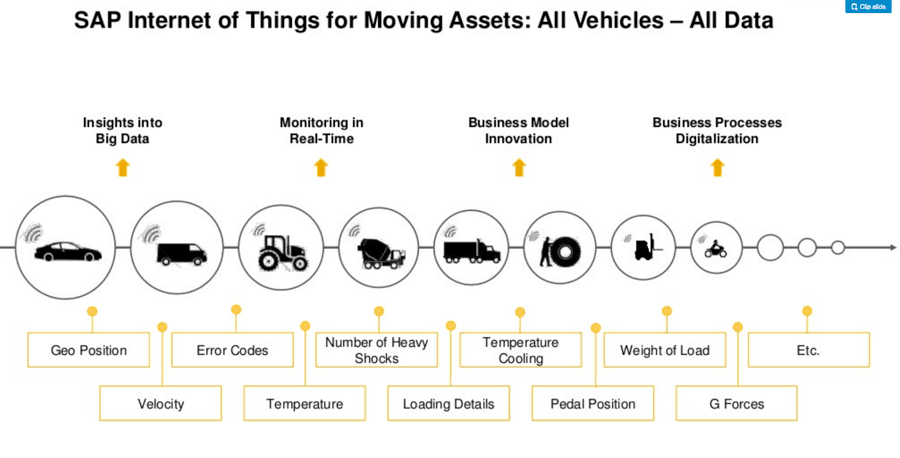
Here you can see SAP is proposing the ability to track all manner of vehicles.
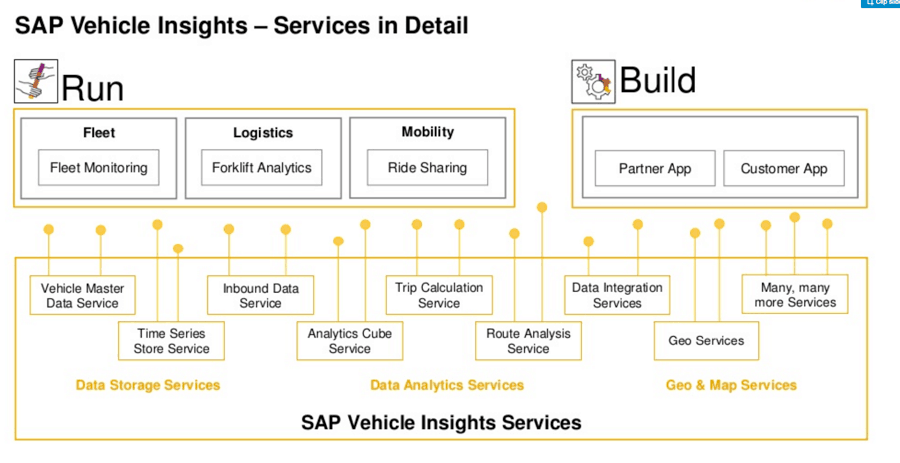
How is SAP going to get information from so many dimensions? We can see Forklift Analytics, Ride Sharing. Where is all of this happening…anywhere?
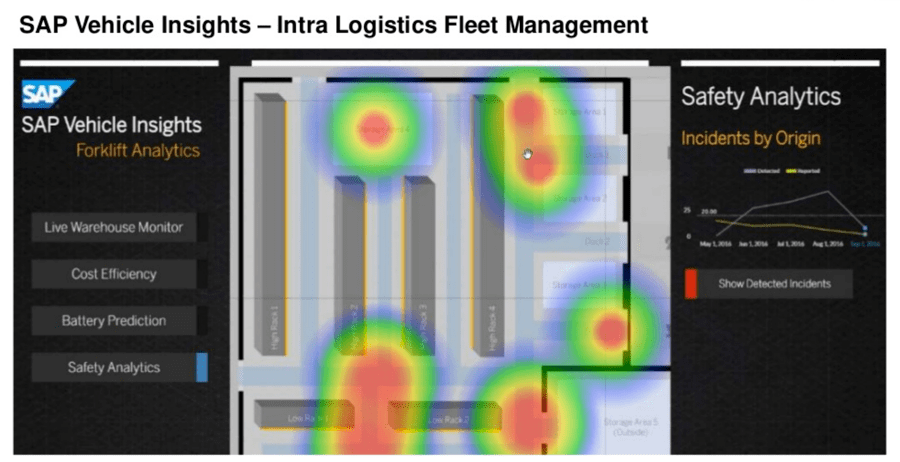 Here is another thing that does not exist and is not used.
Here is another thing that does not exist and is not used.

Where is SAP Vehicle Insights being used? None of my clients use this.
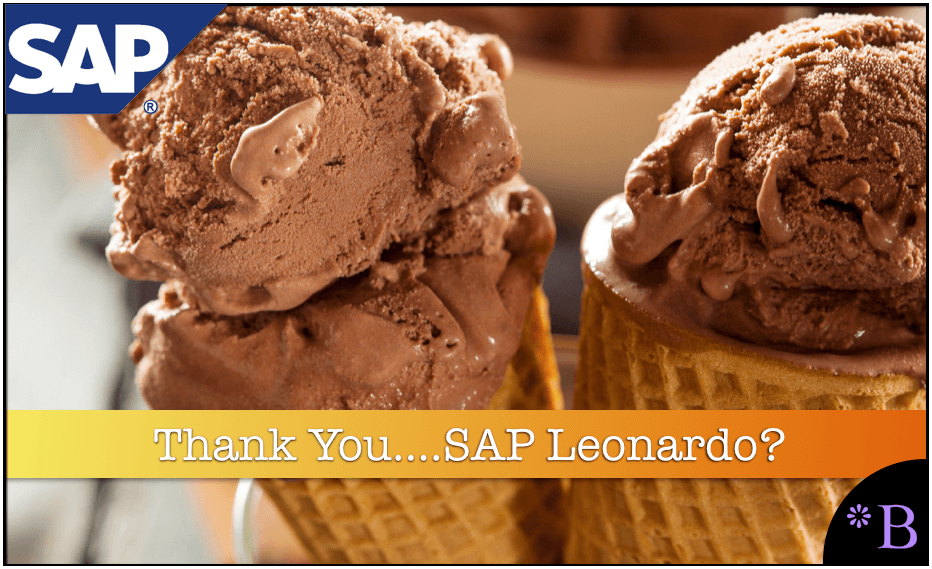
The SAP’s Embarrassing Leonardo Ice Cream Video
*Unfortunately, due to what appears to be an embarrassment, SAP has taken this view down. But the webpage that hosted the video is still at SAP here.
SAP’s Proposal as to the Criticality of Leonardo in Keeping Ice Cream Frozen During Delivery
I can’t recall worrying if ice cream would melt on the way to the house. The reason for this is that I have always lived in countries that had mobile refrigeration. When I was a kid, the ice cream truck drove around the neighborhood playing that enticing music. Again, each ice cream truck had a refrigeration unit, which meant that the ice cream would stay frozen unless the ice cream man ran out of fuel.
All of this occurred before computing, as I used to purchase ice cream from the ice cream man back when almost no one had heard of computers.
Who Was Leonardo Da Vinci Again?
The video takes the strange tact of explaining who Leonardo Da Vinci was.
Is there anyone who does not know who Leonardo Da Vinci was? I understand that Leonardo was named after Da Vinci and not DiCaprio, and we can probably skip the explanation of this well-known icon. In the next SAP video, we can expect an explanation of the Wright Brothers.
Razor Thin Grocery Margins Impact Ice Cream Temperatures?
The video also implies a relationship between the grocery store’s razor-thin margins and melting ice cream. The only way this would be true is if the margins were so small that the grocery chain could not afford to refrigerate their trucks. But all grocery delivery trucks use refrigeration units, so this can’t be true.
The video further implies that grocery chains are now going digital. But is it true that grocery chains like Ralphs or Sprouts did not have computers until just recently or are installing them presently? That seems like an odd proposal to make.
The video states that there is a transition to digital that Leonardo will support or is supporting. But this transition is not established, and outside of SAP saying it, there is no evidence for it. This is because the grocery chains moved to computer-based inventory systems, accounting systems, etc.. decades ago. Delivery trucks have been using GPS for roughly a decade and a half.
The primary transition to storing information in a digital form was in the 1980s, not the 2010’s, or as we are, close to 2020.
We can see where this is headed. This is because we covered the fraudulent use of the term Digital Transformation. This term has been incorrectly reintroduced by SAP. It goes back to the 19th century, as we covered in the article The Problem with Using the Term Digital Transformation for Modern IT Projects.
But the term is nonsense. There is no disputing that the word is popular, but it is nonsense nonetheless.
Digital transformation is a term used to wrap things in a fake blanket of innovation and or prestige.
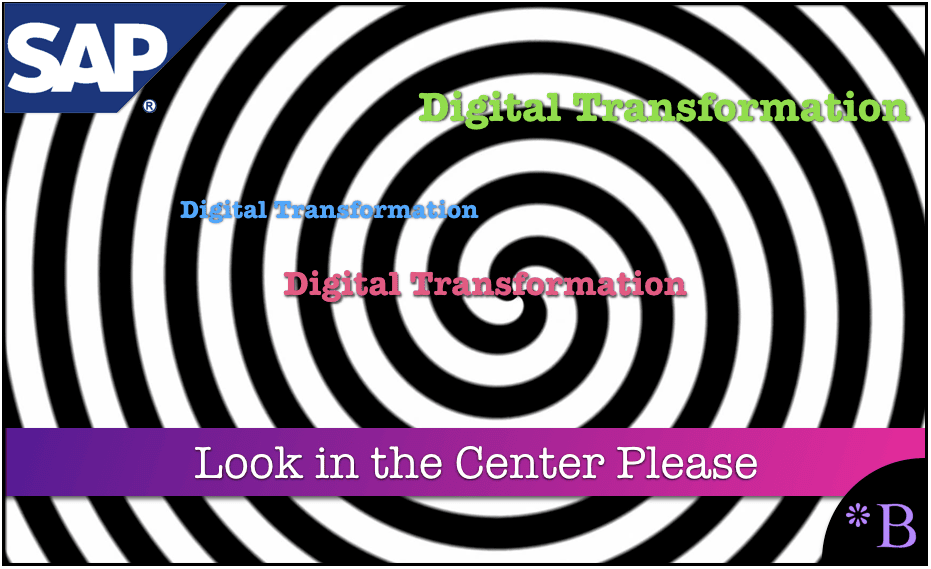
The use of a term like “Digital Transformation” has a specific purpose. It is designed to get the listener or reader to turn off their brains and accept the message being presented because the presenter uses the right “code word.”
A term that carries no information, but is designed to present a desirable context or invoke a subconscious response, is referred to as propaganda.
IoT Prevents Not Only Melted Ice Cream but Spoiled Food?
The video states that IoT monitors refrigeration units to prevent costly breakdowns and spoiled food.
But before we evaluate that claim, first, is it true that mobile refrigeration units been breaking down?
If so, when did this begin becoming a problem?
Furthermore, why do the refrigeration units need to be remotely monitored? Maintenace Checking fluid levels, etc… is performed periodically when the trucks come back to the DC. They go back to the DC nightly or more often than that. What does SAP think happens to the refrigeration units for the 10 hours or out on deliveries?
Insulation Rediscovered!
Insulation means that food does not immediately spoil in the unusual circumstances where the refrigeration unit breaks down. Local delivery is just that, local. Loosely translated, this means the delivery truck is never very far from the DC. It can easily make it back to the DC to have the refrigeration unit repaired.
But again, this implies that refrigeration units break down frequently, and they don’t. It is easy to make highly reliable refrigeration units, and they have been made for a long time. And we will get into that topic in detail further on.
How Is Global Ice Cream Delivery Managing Without Leonardo or IoT?
Furthermore, as a point of comparison, most ice cream in the world is delivered without Leonardo’s benefit. Many ice cream truck operators can’t afford Leonardo. How is all this ice cream staying frozen? Could it be that this has something more to do with the existence of decades of refrigerated trucks?
It seems quite likely.
Real-Time Delivery Information is Necessary for Keeping Ice Cream Frozen?
The video further claims that real-time information shipping information optimizes delivery. But why is this true? Upon inspection, this seems to be another curious claim.
Let us review how truck routing for local delivery works.
A truck is route planned when it leaves the DC. Real-time information allows for what in this scenario exactly? If new orders come in, the truck does not have the inventory to fulfill the order on hand (this is because they were not loaded on the truck as the system had yet to receive the order). It must return to the DC, which it won’t do until it has completed its delivery run.
What all that real-time information about the delivery will accomplish is state the progress of the delivery. However, let’s think this through.
Is this IoT?
Or, more specifically, how is this IoT that has anything to do with SAP?
When I chart my progress around town with Google Maps, is that also IoT? The pace of the delivery can be tracked through Google Maps. Yet, what does that have to do with SAP?
Is SAP involved in route planning? Does that information need to go to the ERP system (excuse me — the digital core)? With SAP’s TM solution, that is rarely implemented? (why is SAP TM still a sold product, by the way?)
The answer to all of the above questions is a resounding no.
SAP’s Confusion on What Does What in the Ice Cream Delivery Process
The video claims that the ice cream then arrives frozen, apparently because of all the previous items listed. But is that really why? SAP seems to misunderstand what computing does versus other components, such as the delivery equipment. That is, the ice cream arrived frozen because the truck is refrigerated.
Kudos to the refrigeration unit on the truck!
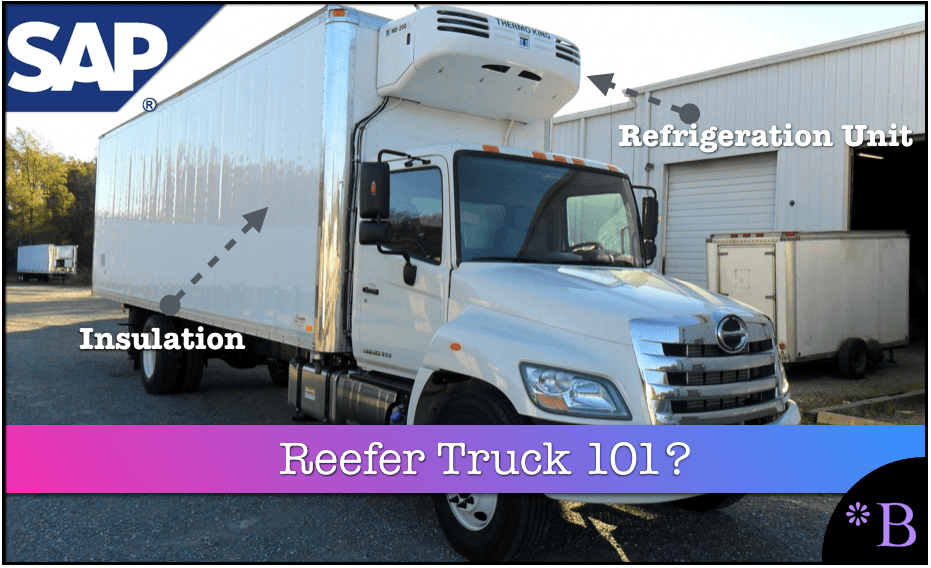
This is a refrigerated truck. The refrigerated unit is in the front. (See the graphic.)
(If you know this already, feel free to skip this part. But this graphic and explanation are really for SAP. They have to, at some point, learn this.)
Two things make the refrigerated truck work.
- The refrigeration unit (it often connect to the diesel tank, so has a virtually unlimited source of fuel), combined with
- The insulation of the truck’s box.
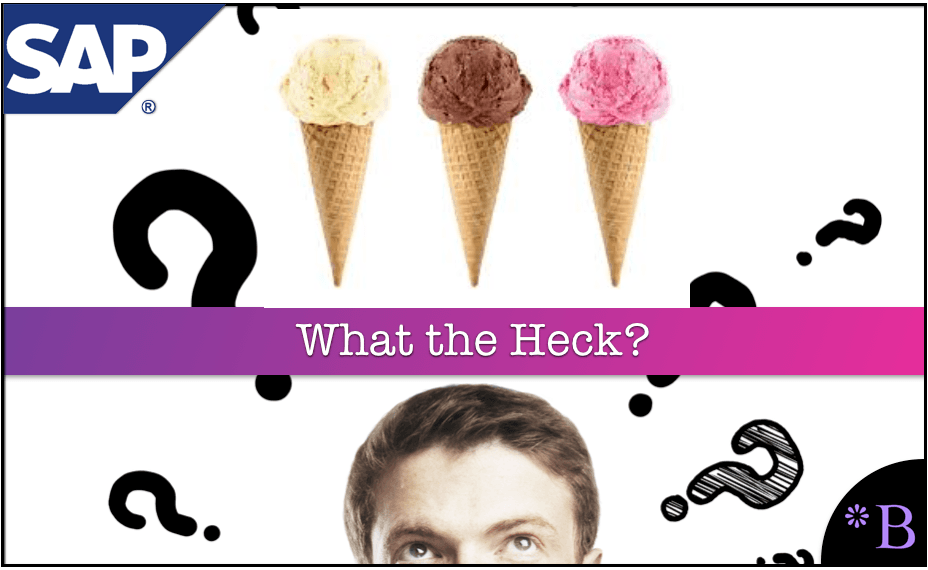
SAP seems deeply confused as to how the ice cream delivery and ice cream refrigeration process works.
SAP’s Confusion on “What Does What” in the Ice Cream Delivery Process
SAP claims to have the world’s best processes in their software. But SAP here can’t figure out what is doing what a simple ice cream delivery process is.
At this point, we are not sure what other parts we also need to articulate. For example, other things that Leonardo does not do is drive the truck. That still requires a human to drive the truck around.
You Need a Digital Partner to Deliver Frozen Ice Cream?
The video finishes by stating that you need a partner to go digital and SAP is that partner. But nothing up to that point explained why SAP is involved in keeping the ice cream frozen. To keep ice cream frozen, you need a refrigeration unit, not a digital partner.
Luckily for you, you can buy a refrigeration unit very easily!
We recommend both Thermo King and Carrier as they have excellent units.
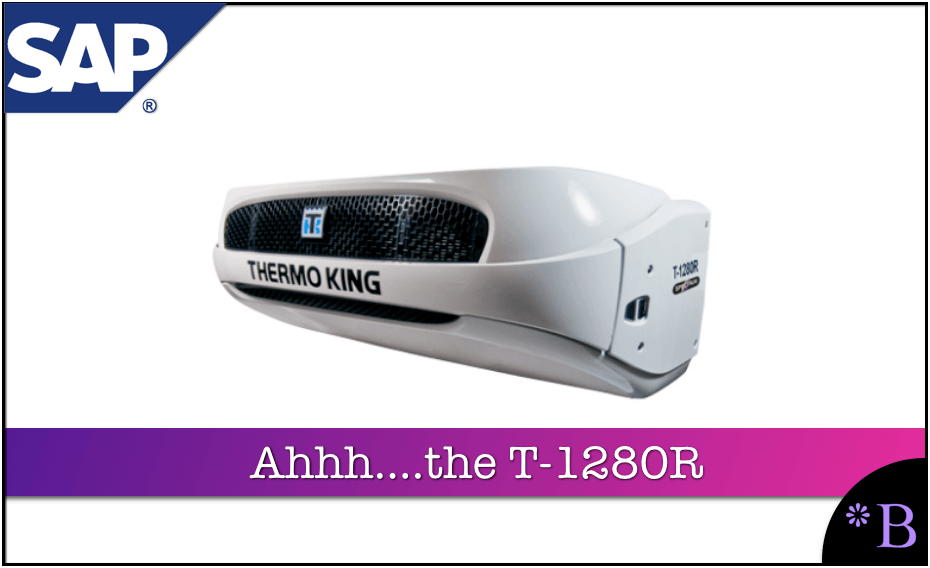
What can we say about the T-1280R that has not been said already? What is not to like. Plus, it has the X-430 compressor.
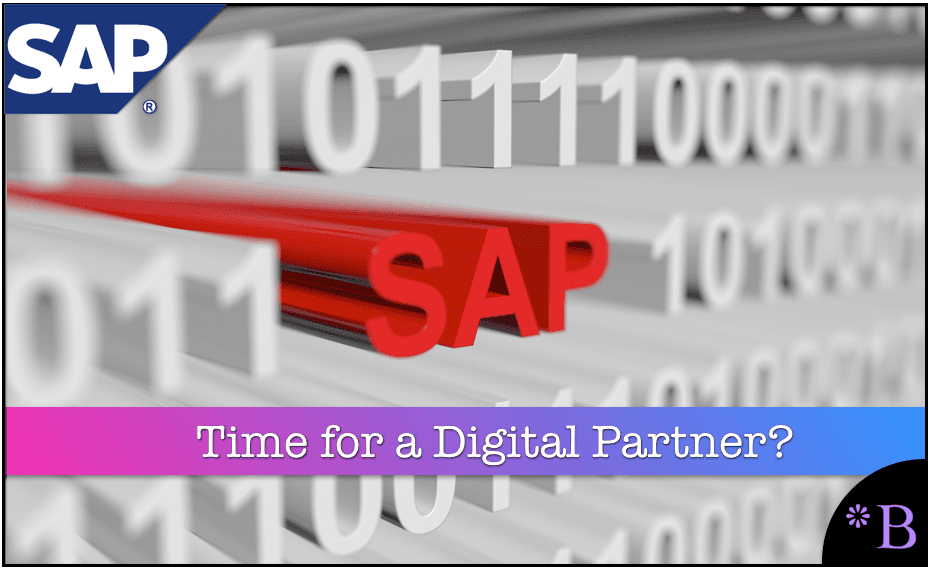
This proposal of a digital partner for helping to deliver ice cream seems a bit sketchy. We would lean more towards the essential transportation and refrigeration equipment.
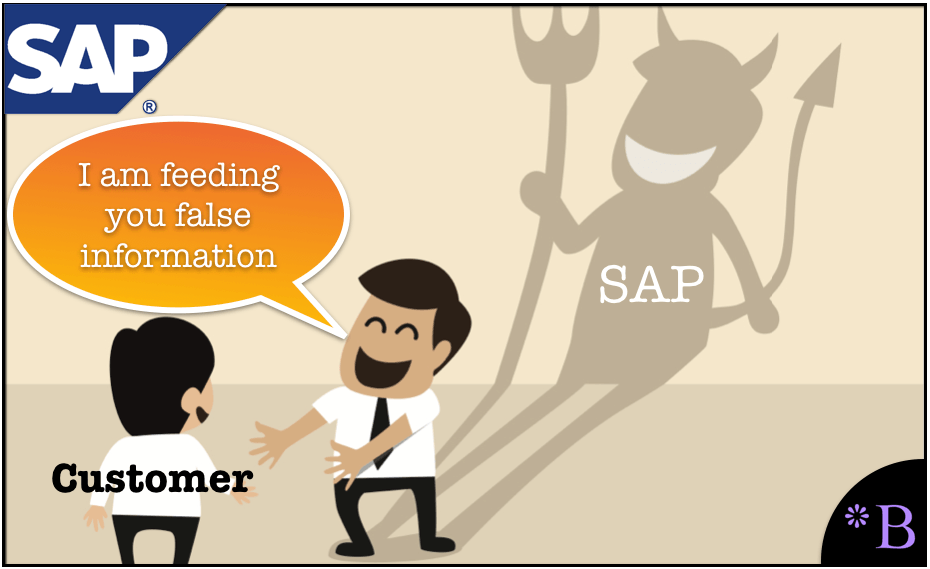
Furthermore, a partner is not someone who lies to you about a process and what they bring to the table. That is an entity that intends to take advantage of you, which is the opposite of a partner.
SAP is not offering to be your partner. If Deloitte or Accenture will implement Leonardo for your ice cream delivery business and support these lies by SAP marketing, they are also not your partner. They are your supplier. SAP or Deloitte could be your partner, but in that case, they would need not to charge you, which is unlikely they will agree to.
False Claims by SAP About Leonardo
Unfortunately for SAP, and perhaps Leonardo, in its quest to penetrate the ice cream delivery business, no one is concerned about ice cream melting on the way to the house. This is primarily because the population in developed countries has become so accustomed to refrigeration that it is an assumption. This fits into a pattern where things claimed by SAP to be improved by IoT aren’t, or aren’t IoT, as we covered in the faux IoT case study on Jabil.
Furthermore, we feel the Thermo King and Carrier would be offended by this video and the notion that their refrigeration units require remote monitoring by Leonardo to keep from breaking down and letting all that ice cream melt. It would be wonderful to point it out if it were true, but the problem is, it isn’t. This is why we have forwarded this article to both companies to obtain their comments.
This video receives a 1 out of 10 for accuracy. SAP’s Leonardo does not have anything to do with why ice cream is delivered in a frozen state.
This unfortunate video indicates that we probably need to increase the education level a bit at SAP marketing. These poor people who skipped most of their science coursework are confused about how and why ice cream stays frozen.
Fortune’s Accuracy on SAP and IoT?
On May 6, 2015, Fortune published the article Why SAP is overhauling its business for the Internet of things.
I this article, we will check the accuracy of this Fortune article.
Article Quotations
At its annual customer conference this week, SAP, the German business software giant, plans to make several announcements that seem designed to appeal only to a chief information officer. But taken together, they are part of a strategy to help businesses cope with the enormous amounts of data created by Internet-connected equipment, employees, or customers. It’s an approach that’s quite familiar in the technology industry of late. Whether you are the chief operating officer of a company that’s trying to track just-in-time inventory against weather patterns, or a chief marketing officer matching your stock price against customer sentiment expressed on Twitter, the techno-industrial giants of the world seek to capitalize on one thing: an executive’s need to gain insight from fast-growing mountains—petabytes—of data. “As an industry we’re still at an exploratory stage of what the Internet of things is going to mean and get our heads around it,” said Quentin Clark, SAP’s chief technology officer. “But its going to turn every enterprise into a technology company.”
Yes, IoT has become a real thing. But Fortune allows SAP to carry on about it without pointing out that SAP does not have much to do with IoT. This is covered in the article Why SAP’s Leonardo Seems to Fake.
Partnerships with GE and IBM
SAP’s goal, like that of GE, IBM, and others, is to become one of the companies selling the shovels and picks of the data-and-services economy that will be built around the Internet of things. (In this metaphor the shovels and picks are tools used in the so-called cloud to analyze and store data generated by Internet-connected sensors. They’re also the platform on which developers build applications that use data to help companies deliver services or new experiences.)
There is no question that SAP likes to sell software. However, again, SAP sells very little IoT software. And still, Fortune is not pointing this out. SAP has a lot of money, and with this money, they can influence or pay Fortune to write articles like this that draw attention away from companies that focus on IoT and get revenues from it.
HANA as the Basis for IoT?
At the center of SAP’s strategy is HANA, its proprietary in-memory database technology that was introduced with much fanfare in 2011. Without getting too much into the weeds, HANA is a big deal because it can handle massive amounts of data really quickly.
It’s also good not to give such a high-level fly-by that you leave the wrong impression.
HANA was introduced in 2011 and has failed to live up to virtually any of the expectations that SAP set for it. Hasso Plattner stated it would represent 20% of SAP’s revenues now, where it is nowhere close to that. They predicted they would be the 2nd largest database globally, and they are nowhere near to that. SAP’s entire strategy for proposing a single database type (HANA’s column-oriented design) for all processing types is out of step with database technology and understanding. HANA is not a “big deal.” It is an inferior investment, especially considering it is easily beaten in performance by competitive products, and being fast is HANA’s only selling point.
That’s important because one of the central ideas behind the Internet of things is that it will generate a lot of data that people or machines will need to immediately react to. HANA therefore is core to SAP’s strategy.
HANA was core to SAP’s strategy, but that strategy failed. HANA did not grow quickly enough and is now stuck at the 19th most popular database, and its growth is has been negative for eight months. This is covered in the article How Popular is HANA?
SAP’s Announcements are Always Accurate?
This week, SAP made one large announcement and a few smaller ones. First, the large: All of SAP’s enterprise resource planning (ERP) software will be optimized to run on HANA in the near future with subscription pricing. This isn’t just big for the Internet of things movement; it also has a major impact on SAP’s business model. Clark did not go into details on pricing, but rest assured, Wall Street analysts will.
Fortune never seems to question whether these announcements are true.
- First, customers should not accept the assumption that it needs to switch out its database to HANA. HANA has a hard time supporting an ERP system, so the concept optimized to run on HANA is not true.
- S/4HANA cannot be run in the public cloud by anything but small companies because 92% of companies customize ECC. S/4HANA has less functionality than ECC.
- Analysts may get into pricing, but Wall Street cannot understand SAP because they approach the company from too high of a level. This is explained in the article How SAP Mislead Analysts in the Q1 2017 Earnings Call.
Pumping Up Fiori?
When a company that makes its money selling software licenses and hefty maintenance fees transitions to a monthly licensing model, the CFO has a plan to explain how this will impact the balance sheet. From a technical perspective SAP is doing exactly what it said it would do earlier this year, which is transition its existing software to the HANA cloud. SAP’s “next generation” business software suite, S4, will run on HANA and sport a single unified interface across all applications.
Clark is talking about Fiori. We covered Fiori in the article What is in the Fiori Box? However, at this time, very few companies use Fiori. And Fiori is not a comprehensive UI for SAP. So Clark’s assertion is inaccurate. What are companies using on projects right now? The vast majority still use SAPGUI, SAP’s old user interface.
Clark explains that this offers a more modern interface for customers—It will look great! It will be responsive on mobile devices!—but it also means that the data sets that customers are using will be stored in HANA and can be re-used across all of their other applications more easily. In many cases, by eliminating the dreaded IT “silos” of different data sets stored in different places, one dumps it all in HANA and can play with it across any application. We’ve heard this promise from the largest IT vendors since 2009, but almost all of them are finally delivering with cloud-based platforms as a service.
The problem with Fiori is that it is primarily a mobile UI. Its technology underpinnings are mobile. But it is not a respected user interface by real user interface specialists, and it may not survive. SAP has had many UI initiatives over the past 15 years, and they have all failed. Fiori is the next one up.
Secondly, HANA will not be the single database for all SAP applications, so that dream is dead.
SAP’s Fantastic IoT Application?
And it’s about time, because the Internet of things will require SAP’s customers to make this transition, even if SAP has to drag them kicking and screaming. To that end SAP has built a dedicated Internet of Things platform on HANA called, cleverly, the SAP HANA Cloud Platform for the Internet of Things. (The naming is almost as distinct as IBM’s Internet of Things Foundation platform.) The SAP offering includes an asset management product, a predictive maintenance and service product, and several other things you might expect if you were managing, monitoring, and building a business around millions of connected devices.
That has been renamed to Leonardo. But there is still not much there. Other IoT vendors are far ahead of SAP, and there is little reason to purchase any IoT related technology from SAP.
SAP is also signing a partnership with its German industrial counterpart Siemens to build what the two are calling Siemens Cloud for Industry as an open cloud platform for analyzing large datasets in the industry. Like GE’s hoping to use its expertise in manufacturing to make its own Predix software and offerings for the Internet of things better, this is a similar effort, only it looks like it will be shared openly—or at least among developers that want to build applications that will live on SAP’s newly launched HANA store.
This may lead to something of significance or may not.
SAP’s App Center?
Yes, like Salesforce.com has its Force.com store where developers can put applications designed for the suite of customer relationship management software, SAP has built an application store where integrators, customers and others can build applications that will help tie other IT resources into HANA. So far more than 800 have. And this is where Clark gets really excited about SAP’s position.
This is the HANA App Center? If so, this is not a relevant item for SAP projects. I have spoken to vendors who have been enticed to put things out at the HANA App Center, but they have not seen much traction from it. Apps should be inexpensive, but the apps out at the HANA App Center are not cheap. They are just partial versions of enterprise expense items.
Because not only will Clark have the tools to make CIOs at big companies happy, he now has the tools to help the CEOs transform the business. The developer-facing platform, where a company’s data can be turned into a valuable asset delivering a differentiated service is where the future lies.
SAP Waxes Philosophically About IoT, and Fortune for Some Reason Cares
Fortune seems very confident of this. Are they verifying anything here or just writing a puff piece?
“For a company to get value out of the Internet of things there are two audiences it has to feed,” said Clark. “Those are business users and developers …and the developer [value] is ultimately expressed on the apps side. If you have a tractor maker and you can sell that tractor maker instrumentation with connected data that offers predictive maintenance and lets him in turn offers services on the other end, that’s going to provide a lot of value for him, that comes back to us.” For SAP, the Internet of things starts with its software, but it’s really services all the way down.
That is nice, but it moves around that SAP has no real IoT business, so why would I care what SAP has to say on this matter? Why not reach out to a real IoT vendor and get their views.
This article by Fortune receives a 1 out of 10 for accuracy. This appears to be another paid placement on the part of SAP to Fortune.
Conclusion
Now SAP has been successful in the past when it brought little to the table, but it needed to have the ERP system to do so. In those cases, ERP did have the data that the connecting system required. But the issue is that SAP’s ERP systems only have a small subset of the “connected” device data in ERP. SAP’s best move would be to offer free services to migrate this data to ERP (not a good step in my estimation, but I am speaking here from what is right for SAP, not suitable for the customer). Then they can sell their customers Leonardo using the same logic they have always used to sell software that is not competitive through its inherent capabilities using the tried and true integration argument.
SAP’s presentation of IoT does not comport with reality. SAP is faking what it has in IoT to lull companies into thinking that SAP has more to offer concerning IoT than they actually do.